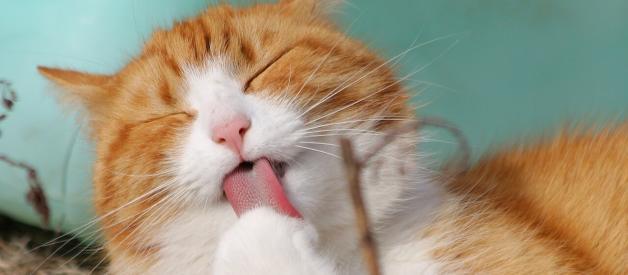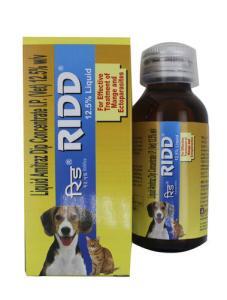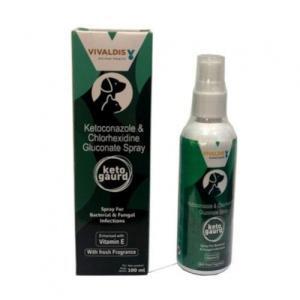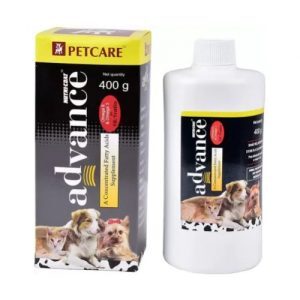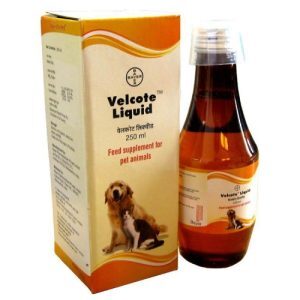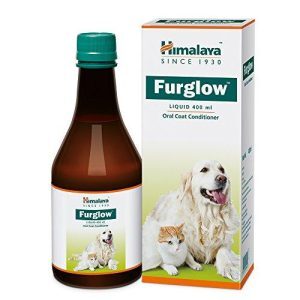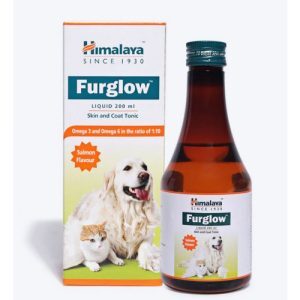Table of Contents
Dermatitis in cats refers to the inflammation of the skin that can be caused by various factors such as allergies, parasites, infections, or irritants, leading to symptoms like itching, redness, and skin lesions.

What Is Dermatitis in Cats?
It is important to treat dermatitis in cats to alleviate their discomfort, prevent further skin damage (skin dermatitis in cats), and address any underlying causes contributing to the condition. Dermatitis in cats encompasses various types, including the following.
Food Allergy in Cats
Food allergies can cause dermatitis in cats. Common allergenic ingredients include beef, dairy products, fish, chicken, and grains. Cats with food allergies may develop itchy skin, gastrointestinal symptoms like vomiting or diarrhea, and sometimes even respiratory issues. Identifying and eliminating the allergenic ingredient from the cat’s diet is essential to manage this type of dermatitis. A veterinarian can only say how to treat food allergy dermatitis in cats after conducting several tests. You may check food allergy dermatitis in cat pictures online.
Flea Allergy Dermatitis in Cats
Some cats are hypersensitive to flea saliva; even a single flea bite can trigger an intense allergic reaction (flea bite allergy dermatitis in cats). Flea allergy dermatitis leads to severe itching (severe allergic dermatitis in cats), hair loss, redness, and skin lesions, particularly around the tail base, lower back, and hindquarters. Effective flea control measures, such as regular flea preventive treatments and environmental control, are crucial to managing this condition. If you suspect flea allergy in your cat, check flea allergy dermatitis in cat pictures online and contact a veterinarian if necessary.
Feline Atopic Dermatitis
Atopic dermatitis in cats is an allergic skin condition caused by environmental allergens such as pollen, dust mites, mold, or certain chemicals. Cats with atopic dermatitis may experience itching, redness, hair loss, and skin infections. Diagnosis involves ruling out other potential causes and may require specialized allergy testing. Atopic dermatitis in cats treatment may include avoidance of allergens, anti-inflammatory medications, and immunotherapy (allergy shots) in severe cases.
Infectious Dermatitis in Cats
Various infections can also cause dermatitis in cats. Bacterial dermatitis in cats may occur due to wounds, bites, or other skin injuries. Fungal infections, such as ringworm, can also lead to cat fungal dermatitis in cats. Parasitic infestations like mange or ear mites can cause intense itching and skin inflammation. Treating the underlying infection through appropriate medications, topical treatments, or in severe cases, systemic therapies is essential to resolve infectious dermatitis.
Seasonal Dermatitis in Cats (Nasal Dermatitis)
Seasonal dermatitis in cats is a condition characterized by recurrent inflammation during specific seasons, often due to environmental allergens such as pollen or mold.
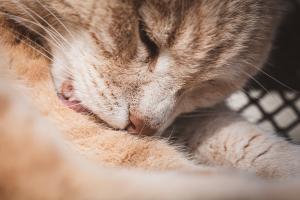
Causes of Dermatitis in Cats
What causes dermatitis in cats? Dermatitis in cats can have various causes. Some common causes include:
- Cats can develop allergic reactions to certain substances, including food ingredients, environmental allergens (pollen, dust mites, mold), or chemicals (cleaning products, certain fabrics). Allergies can manifest as dermatitis, causing itching, redness, and skin inflammation.
- External parasites like fleas, ticks, and mites can cause cat dermatitis. Flea bites, in particular, can trigger allergic reactions known as flea allergy dermatitis. Check with your veterinarian best treatment for flea allergy dermatitis in cats. Also, ask them about cat flea allergy dermatitis in humans.
- Bacterial, fungal, or parasitic infections can result in dermatitis. Bacterial infections may occur due to wounds, scratches, or bites, while fungal infections like ringworm can cause skin inflammation. Parasitic infestations such as mange or ear mites can also lead to dermatitis.
- Cats may develop dermatitis due to contact with irritants such as certain chemicals, detergents, or plants. These substances can cause skin irritation, redness, and inflammation upon contact.
- Sometimes, the cat’s immune system may mistakenly attack its skin, leading to dermatitis. Autoimmune disorders like pemphigus or eosinophilic granuloma complex can cause skin lesions and inflammation.
- Skin trauma, such as excessive scratching, licking, or biting, can result in secondary dermatitis. Constant self-inflicted trauma can damage the skin’s barrier, making it more susceptible to inflammation and infection.
Symptoms of Atopic Dermatitis in Cats
The symptoms of atopic dermatitis in cats can vary but often include:
- Itching (pruritus): Cats with atopic dermatitis typically experience intense itching, which can be generalized or localized to specific body areas. Flea allergy dermatitis in cats has the same symptom.
- Skin redness and inflammation: Affected areas of the skin may appear reddened and inflamed. This can be seen as patches or widespread redness, depending on the severity and extent of the dermatitis.
- Hair loss: Due to excessive scratching or licking, cats with atopic dermatitis may have areas of hair loss or thinning fur.
- Skin lesions: The constant scratching and rubbing can cause skin lesions such as papules (small raised bumps), crusts, or open sores. These lesions may be prone to secondary bacterial or fungal infections.
- Facial and ear involvement: Cats with atopic dermatitis often show symptoms on the face, especially around the eyes, muzzle, and ears. They may have redness, swelling, and itching in these areas.
- Self-trauma: Cats with atopic dermatitis may use excessive grooming or scratching to relieve the itching, leading to self-inflicted injuries and further skin damage.
- Changes in behavior: Cats may become irritable, restless, or exhibit signs of discomfort due to constant itching and skin irritation.
These symptoms can also be seen in other types of dermatitis or skin conditions. Hence, a proper diagnosis by a veterinarian is necessary to differentiate atopic dermatitis from other causes and develop an appropriate treatment plan.
Diagnosis
Diagnosing atopic dermatitis in cats typically involves a combination of medical history evaluation, physical examination, and ruling out other potential causes of similar symptoms.
The veterinarian will gather detailed information about the cat’s symptoms, including the onset, duration, and progression of dermatitis, as well as any potential triggers or patterns.
A thorough examination of the cat’s skin will be conducted to assess the affected areas, look for signs of inflammation, redness, and lesions, and evaluate the overall condition of the skin and coat.
Since the symptoms of atopic dermatitis can overlap with other skin conditions, the veterinarian may perform tests or procedures to rule out other possible causes before prescribing antihistamines for dermatitis in cats. This may include tests for a flea infestation, skin scrapings for mites, fungal culture for ringworm or skin cytology to identify bacterial or yeast infections.
Allergy testing may be recommended to identify potential allergens that could trigger the dermatitis. Intradermal testing involves injecting small amounts of allergens under the skin to observe an allergic reaction. Serological testing, such as blood tests, may also detect specific antibodies to common allergens.
A strict elimination diet or food trial may be conducted to identify specific food allergens if a food allergy is suspected. This involves feeding the cat a novel protein and carbohydrate source they have not been exposed before and closely monitoring for any improvement in symptoms.
The cat’s response to specific treatments, such as anti-inflammatory medications or immunosuppressive drugs, may help confirm a diagnosis of atopic dermatitis. Then the veterinarian prescribes atopic dermatitis treatment or will tell how to cure flea allergy dermatitis in cats.
Treatment for Dermatitis in Cats
How to cure allergic dermatitis in cats?
Cat dermatitis may involve addressing the underlying cause, such as allergies or infections. It may include medication, topical treatments, dietary changes, environmental management, and supportive care to relieve symptoms and promote skin healing.
RIDD (Amitraz), 12,5%
RIDD is a flea allergy dermatitis in cats treatment. It is a topical medication that contains Amitraz as its active ingredient.
Ingredients
Amitraz is an acaricide and insecticide commonly used to treat ticks, mites, and lice infestations. It affects the nervous system of these parasites, leading to their paralysis and eventual death.
RIDD is used to treat and control various external parasite infestations in cats, including ticks and mites.
Administering
The specific dosage, usage instructions, and frequency may vary depending on the cat’s weight, the severity of the infestation, and the veterinarian’s recommendation. Following the veterinarian’s instructions and the dosage guidelines mentioned on the product label is important.
RIDD is typically applied topically, directly onto the cat’s skin, following the manufacturer’s instructions. It is important to ensure that the product is applied only to areas specified by the instructions and to avoid contact with the cat’s eyes, nose, or mouth. The frequency of application may vary depending on the severity of the infestation.
Benefits
- RIDD is effective against ticks, helping to eliminate and control tick infestations on cats. Ticks can transmit diseases, so preventing and treating infestations is crucial for the cat’s health.
- RIDD is also effective against certain mites, including Demodex and Sarcoptes mites. Mite infestations can cause skin irritation, itching, and other discomfort for cats, so treating them is essential for their well-being.
Keto Guard (Ketoconazole, Chlorhexidine Gluconate) 1%/2% 100ml
Keto Guard is a topical medication that contains two active ingredients: Ketoconazole and Chlorhexidine Gluconate. Keto Guard is typically used in cats to treat dermatitis caused by fungal or yeast infections. It is commonly prescribed for conditions like ringworm or Malassezia dermatitis. The medication is applied topically to the affected areas of the skin.
Ingredients
Ketoconazole is an antifungal medication that inhibits the growth of fungi and yeast. It is effective against various fungal infections, including ringworm (dermatophytosis), Malassezia dermatitis, and some yeast infections. Ketoconazole helps to eliminate the fungi causing dermatitis and reduces associated symptoms like itching and inflammation.
Chlorhexidine Gluconate is an antiseptic and antimicrobial agent that helps to prevent or control bacterial and fungal infections. Chlorhexidine gluconate has broad-spectrum activity against various microorganisms, including bacteria and yeast. It helps to cleanse the affected skin, control infection, and promote healing.
How to Use
The specific usage instructions may vary depending on the veterinarian’s recommendation and the severity of the condition. Generally, Keto Guard is applied to clean and dry skin. Applying a thin layer of the medication once or twice daily to the affected areas is typically recommended.
The benefits of using Keto Guard
- Antifungal and antimicrobial action: The active ingredients, Ketoconazole and Chlorhexidine Gluconate, work together to combat fungal and bacterial infections that may be contributing to dermatitis.
- Symptom relief: By addressing the underlying infection, Keto Guard helps to alleviate symptoms associated with dermatitis, such as itching, redness, and inflammation.
- Promotes healing: The medication aids in the healing process of the affected skin by controlling infection and reducing the spread of fungi and bacteria.
Nutri-Coat Advance (Omega 3, Omega 6) 200g, 400g
Nutri-Coat Advance is a nutritional supplement for cats that contains Omega-3 and Omega-6 fatty acids. Nutri-Coat Advance is a dietary supplement to provide cats with a balanced ratio of Omega-3 and Omega-6 fatty acids. It supports the immune system and helps in dermatitis treatment. It is a natural treatment for flea allergy dermatitis in cats.
Ingredients
Omega-3 Fatty Acids are essential fatty acids crucial in maintaining overall health. The specific omega-3 fatty acids found in Nutri-Coat Advance are commonly derived from fish oil or plant-based sources like flaxseed oil. Omega-3 fatty acids, such as eicosapentaenoic acid (EPA) and docosahexaenoic acid (DHA), are anti-inflammatory and contribute to healthy skin, coat, and immune system function.
Omega-6 Fatty Acids are also essential for cats and often derived from sunflower or evening primrose oil. They include linoleic acid and gamma-linolenic acid (GLA). Omega-6 fatty acids are necessary to maintain healthy skin, promote a shiny coat, and support proper immune function.
Administering
The specific dosage and usage instructions may vary depending on the cat’s weight, health condition, and the veterinarian’s recommendation. It is typically administered orally by mixing the supplement with the cat’s food. The recommended frequency of use is usually once or twice daily, as directed by the veterinarian or stated on the product label.
Benefits
- Skin and Coat Health: Omega-3 and Omega-6 fatty acids are vital for maintaining healthy skin and a lustrous coat in cats. They help reduce itching, flakiness, and dryness while promoting a soft, shiny coat.
- Anti-Inflammatory Effects: Omega-3 fatty acids, especially EPA and DHA, have anti-inflammatory properties. They can help alleviate symptoms associated with inflammatory skin conditions, such as dermatitis or allergies.
- Immune System Support: The fatty acids in Nutri-Coat Advance contribute to a healthy immune system, which is essential for a cat’s overall well-being and defense against infections.
Velcote (Vitamins A, D3, E) 250 ml
Velcote is a nutritional supplement for cats that contains Vitamins A, D3, and E. Velcote is used as a dietary supplement to provide cats with adequate levels of these essential vitamins. Improving the immune system, it helps to cure dermatitis in cats.
Ingredients
Vitamin A is an essential nutrient in maintaining healthy skin, vision, and immune function. It is important for the growth and development of tissues and helps support the integrity of the skin and mucous membranes.
Vitamin D3, or cholecalciferol, is crucial for proper calcium and phosphorus absorption and utilization in the body. It helps in maintaining healthy bones, teeth, and neuromuscular function.
Vitamin E is a potent antioxidant that helps protect cells from oxidative damage. It supports healthy skin, promotes immune function, and aids in the maintenance of healthy muscles and nerves.
Administering
The specific dosage and usage instructions may vary depending on the cat’s weight, health condition, and the veterinarian’s recommendation. Velcote is typically administered orally by mixing the supplement with the cat’s food. The recommended frequency of use is usually once daily, as directed by the veterinarian or stated on the product label.
Benefits
- Vitamins A, D3, and E contribute to the skin’s and coat’s overall health, promoting a shiny, smooth, and well-nourished coat.
- Vitamin A plays a crucial role in maintaining good vision. Adequate levels of vitamin A can help support optimal eye health in cats.
- The vitamins in Velcote, particularly vitamins A and E, help support the cat’s immune system, assisting in its ability to fight off infections and maintain overall health.
- Vitamin D3 is essential for calcium and phosphorus metabolism, vital for developing and maintaining healthy bones and muscles in cats.
Furglow Oral Coat Conditioner (Vitamin A, Vitamin E, Selenium, Zinc) 200ml
Furglow Oral Coat Conditioner is a nutritional supplement for cats that contains Vitamin A, Vitamin E, Selenium, and Zinc. Furglow Oral Coat Conditioner is a dietary supplement to provide cats with these essential vitamins and minerals to keep the cat’s coat and skin healthy, eliminating dermatitis symptoms.
Ingredients
Vitamin A is essential to maintaining healthy skin, coat, and vision. It supports the growth and development of tissues and promotes the integrity of the skin and mucous membranes.
Vitamin E is a potent antioxidant that helps protect cells from oxidative damage. It contributes to healthy skin and coat, supports immune function, and aids in the maintenance of healthy muscles and nerves.
Selenium is a trace mineral that acts as an antioxidant and is necessary for proper immune system function. It helps protect cells from oxidative stress, supports a healthy immune response, and promotes overall well-being.
Zinc is an essential mineral involved in various enzymatic reactions in the body. It plays a role in maintaining healthy skin and coat, supports immune function, and aids in healing.
Administering
The specific dosage and usage instructions may vary depending on the cat’s weight, health condition, and the veterinarian’s recommendation. Furglow Oral Coat Conditioner is typically administered orally by mixing it with the cat’s food or directly into the mouth. The recommended frequency of use is usually once daily, as directed by the veterinarian or stated on the product label.
Benefits
- Combining Vitamin A, Vitamin E, Selenium, and Zinc helps promote healthy skin and a shiny, lustrous coat in cats. It supports the integrity of the skin and contributes to a healthy, well-nourished coat.
- Vitamin E and Selenium act as antioxidants, helping to protect cells from oxidative damage caused by free radicals. This can benefit the overall health and well-being of cats.
- Selenium and Zinc are important for proper immune system function. They contribute to a strong immune response, helping cats to defend against infections and maintain overall health.
Furglow Skin And Coat Tonic (Minerals, Vitamin A, Vitamin E, Selenium, Zinc) 200 ml
Furglow Skin and Coat Tonic is a nutritional supplement for cats that contains Minerals, Vitamin A, Vitamin E, Selenium, and Zinc. Furglow Skin and Coat Tonic is a dietary supplement to provide cats with these essential vitamins, minerals, selenium, and Zinc that help treat dermatitis.
Ingredients
The specific minerals in Furglow Skin and Coat Tonic are not specified. However, minerals are important in various physiological functions, including skin and coat health. Common minerals that benefit the skin and coat include copper, iron, and manganese.
Vitamin A is an essential nutrient that supports healthy skin, coat, and vision. It promotes the growth and maintenance of tissues, including the skin and mucous membranes.
Vitamin E is a powerful antioxidant that helps protect cells from oxidative damage. It contributes to healthy skin and coat, supports immune function, and aids in the maintenance of healthy muscles and nerves.
Selenium is a trace mineral that acts as an antioxidant and is necessary for proper immune system function. It helps protect cells from oxidative stress, supports a healthy immune response, and promotes overall well-being.
Zinc is an essential mineral involved in various enzymatic reactions in the body. It plays a role in maintaining healthy skin and coat, supports immune function, and aids in healing.
Administering
The specific dosage and usage instructions may vary depending on the cat’s weight, health condition, and the veterinarian’s recommendation. Furglow Skin and Coat Tonic is typically administered orally by mixing it with the cat’s food or directly into the mouth. The recommended frequency of use is usually once daily, as directed by the veterinarian or stated on the product label.
Benefits
- Skin and Coat Health: Combining minerals, Vitamin A, Vitamin E, Selenium, and Zinc helps promote healthy skin and a shiny, lustrous coat in cats. They support the integrity of the skin, contribute to a healthy, well-nourished coat, and aid in maintaining overall skin health.
- Antioxidant Protection: Vitamin E, Selenium, and other antioxidants in the supplement help protect cells from oxidative damage caused by free radicals. This can benefit the overall health and well-being of cats.
- Immune System Support: Selenium and Zinc are important for proper immune system function. They contribute to a strong immune response, helping cats to defend against infections and maintain overall health.
It’s important to consult a veterinarian before using these products or any other nutritional supplement for your cat. They can guide the appropriate dosage and usage based on your cat’s specific needs and ensure it complements their overall diet and health.
How to Prevent Dermatitis
Preventing dermatitis in cats involves taking proactive measures to minimize potential triggers and maintain their skin health.
Use effective flea control methods regularly to prevent flea infestations. This includes topical or oral flea preventive medications approved for cats and keeping the cat’s environment clean and free of fleas.
If your cat has known allergies, work with your veterinarian to identify and manage allergens. This may involve avoiding specific foods or environmental triggers that cause allergic reactions.
Provide a balanced and nutritious diet to support your cat’s overall health, including skin and coat. Please consult your veterinarian to ensure the cat’s diet meets its nutritional requirements.
Regular grooming sessions help maintain a healthy coat and skin. Brushing helps remove loose hair and debris, reducing the risk of matting and skin irritation. Be gentle during grooming to avoid causing skin damage.
Minimize exposure to potential irritants and allergens in the cat’s environment. This may include reducing the use of harsh chemicals, ensuring proper ventilation, and providing a clean and stress-free living space.
Schedule routine veterinary visits for your cat. Regular check-ups allow your veterinarian to assess your cat’s overall health, detect any skin issues early on, and provide appropriate preventive care.
While cats generally groom themselves, occasional baths may be necessary to keep their skin clean. Use cat-specific shampoos recommended by your veterinarian and follow proper bathing techniques. Avoid over-bathing, as it can strip the skin of natural oils.
Minimize stress in your cat’s environment, which can contribute to dermatitis. Provide a calm and enriching environment, and ensure they have a comfortable space for relaxation and play.
Remember, it’s important to consult a veterinarian for personalized guidance and advice on preventive measures for your cat’s needs and health condition.
FAQ
How Long Does Flea Allergy Dermatitis Last in Cats?
The duration of flea allergy dermatitis in cats can vary depending on the severity of the reaction, the effectiveness of flea control measures, and ongoing flea exposure. With proper treatment and effective flea prevention, symptoms can improve within a few weeks. However, chronic allergic dermatitis in cats or recurrent flare-ups may sometimes occur, requiring ongoing management.
What Does Flea Allergy Dermatitis Look Like in Cats?
Flea allergy dermatitis in cats typically presents with specific symptoms. Common signs include intense itching, hair loss (especially around the tail base and hindquarters), redness, skin inflammation, small red bumps or scabs, and tiny black or dark dots (flea dirt) on the skin or fur. Cats may excessively groom, scratch, or bite at the affected areas.
Is Miliary Dermatitis in Cats Contagious?
Miliary dermatitis in cats is not contagious in the typical sense. A contagious agent does not cause it but rather is a skin reaction pattern. What is miliary dermatitis in a cat? Feline miliary dermatitis is when cats develop small, raised bumps or scabs resembling millet seeds on their skin. It is usually signs of an underlying issue such as allergies, parasites, or skin infections. While the condition is not contagious, the underlying cause of miliary dermatitis in cats (such as fleas or certain infections) may be contagious and require appropriate treatment to prevent transmission. Your vet will help with the best over-the-counter treatment for miliary dermatitis in cats or home remedies for miliary dermatitis in cats.

